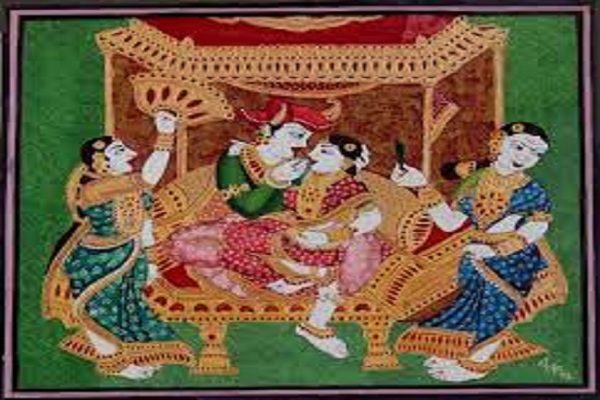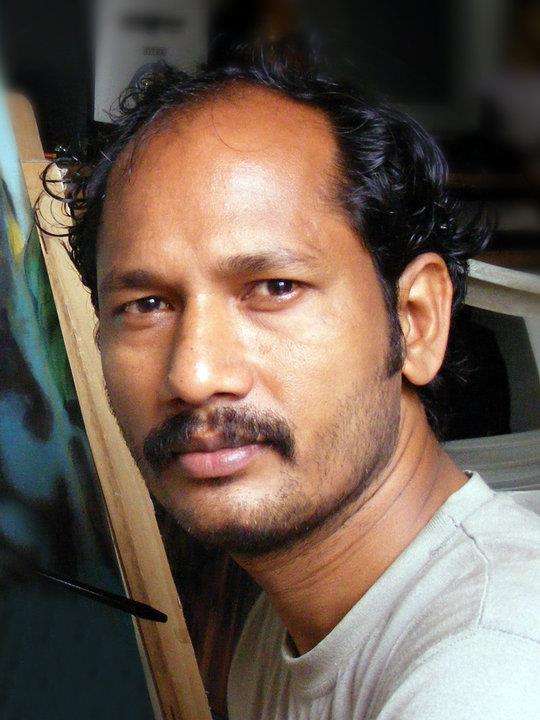
Sell Art with Indian Art Ideas
Painting, sculpture, ceramics, and textile arts such as woven silk are among the many kinds of Indian art. Geographically, it includes what is now India, Pakistan, Bangladesh, Sri Lanka, and Nepal, as well as the rest of the Indian subcontinent. Indian art is known for its great sense of design, which can be seen in both modern and traditional forms.
The origins of Indian art can be traced back to 3rd millennium BC prehistoric villages. Indian art has been influenced by cultural as well as religious influences such as Hinduism, Buddhism, Jainism, Sikhism, and Islam on its way to modern times. Despite this complicated mix of religious traditions, the major religious groupings have generally shared the dominant creative style at any given period and place.
Early Indian Art
Some (but not all) of India's rock relief carvings, engravings, and paintings date from the South Asian Stone Age. There are over 1300 rock art sites with over a quarter of a million figures and figurines, according to estimates. Archibald Carlleyle discovered the first rock engravings in India twelve years before the Cave of Altamira in Spain, though his work was not discovered until much later, thanks to J Cockburn (1899).
Dr. V. S. Wakankar discovered several painted rock shelters near the Vindhya mountain range in Central India. The Bhimbetka rock shelters, which consist of over 750 monuments, have been designated as a UNESCO World Heritage Site; the oldest paintings date back 10,000 years. These sites' paintings frequently featured depictions of human life alongside animals, as well as hunts using stone implements. Their style differed depending on region and antiquity, but the most typical feature was a red wash formed with a powdered mineral called geru, which is a type of Iron Oxide.
The Indus Valley Civilization (c. 3300 BC – c. 1750 BC)
It was a civilization that flourished in the Indus Valley.
Despite its vastness and sophistication, unlike many other early civilizations, the Indus Valley civilization appears to have had no interest in public large-scale art. The presence of some types of dance can be seen in a variety of gold, terracotta, and stone figures depicting girls in dancing stances. There were also cows, bears, monkeys, and dogs among the terracotta figurines.
Small carved seals are the most typical type of figurative art encountered. Thousands of steatite seals have been discovered, all of which have a similar physical appearance. They range in size from 34 to 112 inches square. They typically have a perforated boss on the back to permit a cord for handling or personal ornamentation.
At Mohenjo-Daro, seals depicting a figure standing on its head and another, on the Pashupati Seal, sitting cross-legged in a yoga-like stance have been discovered. This figure has been attributed to a variety of people. Sir John Marshall noted a likeness to Shiva, the Hindu god.
The animal portrayed on the bulk of seals at mature period sites has yet to be identified. It has been a matter of speculation because it is part bull, part zebra, and has a spectacular horn. Although there is now little evidence to support assertions that the image had religious or cultist significance, the image's widespread use raises the question of whether the animals depicted in IVC images are religious symbols.
Vedic period
There are no anthropomorphic depictions in the millennium after the collapse of the Indus Valley Civilisation, which coincided with the Indo-Aryan migration during the Vedic period. It has been suggested that early Vedic religion was only concerned with the worship of "elementary forces of nature" through complex sacrifices, which did not lend themselves well to anthropomorphological depictions.
The Copper Hoard Culture may be represented by a number of items, some of which include anthropomorphological traits. The actual meaning of these items, as well as the culture and periodization to which they belonged, has been debated. Abstract pottery designs emerge in the Black and Red Ware culture (1450-1200 BCE) and the Painted Grey Ware culture (1200-600 BCE), including finds in the Black and Red Ware culture (1450-1200 BCE) and the Painted Grey Ware culture (1200-600 BCE).
Mauryan art (c. 322 BCE – c. 185 BCE)
The Maurya Empire flourished in northern India from 322 BCE to 185 BCE, and at its peak, it ruled the whole subcontinent save for the extreme south, as well as influences from Indian old traditions and Ancient Persia, as evidenced by the Pataliputra capital.
Although very little decoration from the Mauryan period survives, and there may not have been much in the first place, the emperor Ashoka, who died in 232 BCE, adopted Buddhism about half-way through his 40-year reign and patronized several large stupas at key sites from the Buddha's life, although very little decoration from the Mauryan period survives, and there may not have been much in the first place. More information can be found at different early Indian rock-cut architecture sites.
Colossal Yaksha statuary (2nd century BCE)
Yakshas appear to have been the subject of a significant worship in early Indian history, with many of them being known as Kubera, Yaksha's King, Manibhadra, or Mudgarpani. The Yakshas are a broad class of nature spirits who are associated with water, fertility, trees, the forest, treasure, and wilderness, and are often mischievous or capricious.
.Yashas are frequently shown with weapons or qualities, such as the Yaksha Mudgarpani, who holds a mudgar mace in her right hand and a small standing devotee or kid in her left hand, linking hands in prayer. The huge Yaksha statuary's style is thought to have had a significant influence on the construction of later god representations and human figures in India. The Yashinis, who were often associated with trees and children and whose voluptuous figures became omnipresent in Indian art, were the female equivalents of the Yashas.
The geometrical folds of the draperies and the walking attitude of the statues have been attributed to Hellenistic influence.
Buddhist art (c. 150 BCE – c. 500 CE)
The great Buddhist art surviving periods begin after the Mauryans, with large quantities of sculpture surviving. Sanchi, Bharhut, and Amaravati are three important sites, with some remaining in situ and others in museums in India and around the world. Stupas were encircled by ceremonial fences that had four ornately carved toranas or ornamental gates facing the cardinal directions.
These are made of stone, yet they obviously follow the forms that were formed in wood. They, as well as the stupa's walls, can be richly adorned with reliefs, most of which depict the Buddha's life. Life-size statues were gradually sculpted, first in deep relief and subsequently free-standing. Mathura was the most important center in this development, which encompassed Hindu, Jain, and Buddhist art.
Rock-cut chaitya prayer halls and monastic viharas have fared better than similar free-standing structures elsewhere, which were usually made of wood for a long time. Early sculpture can be found in Ajanta, Karle, Bhaja, and other caves, but it is often overshadowed by later works such as iconic figures of the Buddha and bodhisattvas, which are not dated before at least 100 CE.
Buddhism began to place a greater emphasis on Buddha sculptures, which were heavily affected by Hindu and Jain religious figurative art. The figures of this time were also impacted by Greco-Buddhist art from the decades after Alexander the Great's conquests. This merger took place in India's far northwestern regions, particularly Gandhara, which is now part of Afghanistan and Pakistan.
Shunga Dynasty (c. 185 BCE – 72 BCE)
With the fall of the Maurya Empire, governance of India reverted to regional kingdoms, one of the most important of which was the Shunga Dynasty of central India (c. 185 BCE – 72 BCE). Some of the most important early Buddhist architecture was produced during this period, as well as during the Satavahana Dynasty, which flourished concurrently with the Shunga Dynasty in south India. The stupa, a religious structure that usually houses a precious Buddhist relic, is arguably the most notable construction of this dynasty. These relics were frequently, but not always, linked to the Buddha in some form.
The Great Stupa at Sanchi, one of the most famous Buddhist stupas from the Shunga Dynasty, is supposed to have been built by Mauryan emperor Ashoka between 273 and 232 BCE during the Maurya Empire. During the Shunga Dynasty (c. 150 BCE - 50 BCE), the Great Stupa was extended to its current diameter of 120 feet, covered with a stone casing, topped with a balcony and parasol, and encircled with a stone railing.
The finely formed terracotta plaques are another important art form of the Shunga Dynasty, in addition to architecture. The Shunga Dynasty's terracotta plaques follow a style that emphasizes surface detail, nuance, and sensuality, as seen in prior examples from the Mauryan Empire. Women, some of whom are assumed to be goddesses, are the most common figural representations featured on these plaques, who are generally represented bare-chested and wearing ornate headdresses.
Satavahana dynasty (c. 1st/3rd century BCE – c. 3rd century CE)
The Satavahana dynasty controlled central India, and the Amaravati Stupa, the Karla Caves, and the first phase of the Ajanta Caves were among the many significant Buddhist structures, stupas, temples, and prayer halls they financed. Bimbisara and his royal entourage set off from Rajagriha to pay a visit to the Buddha.
Stupas are religious structures that are built on top of burial mounds and house treasures beneath a solid dome. Stupas in different parts of India may differ in structure, size, and design, but their symbolic connotations are quite similar. They're based on a mandala, a Buddhist-inspired pattern of the cosmos. A sacred route for Buddhist followers to undertake devotional circumambulation in ritual settings is provided by a railing on a conventional stupa.
Buddhist relief sculptures and epigraphs written in Brahmi characters are frequently found in sacred Buddhist sites. Satavahana people made stone images as decorations in Buddhist buildings to honor the divine. They used a variety of intricate procedures and instruments, such as chisels, hammers, and compasses with iron points, to produce ideal representations based on their knowledge of geometry and geology. Furthermore, elegant Satavahana coins demonstrate the period's artistic ability. The Satavahanas primarily issued copper, lead, and potin coins. Silver was later used in the production of coins. The coins usually feature elaborate portraits of kings as well as inscriptions in Tamil and Telugu.
Mughal art
Despite the fact that Islamic conquests in India began in the first part of the 10th century, it was not until the Mughal Empire that emperors with a taste for the fine arts were seen. Emperor Humayun brought with him Mir Sayyid Ali and Abd al-Samad, two of the best painters from Persian Shah Tahmasp's famed workshop, when he reestablished the Delhi Sultanate in 1555.
During Akbar's reign, the number of painters increased from around 30 when the Hamzanama was built in the mid-1560s to around 130 by the mid-1590s. According to court historian Abu'l-Fazal, Akbar was a hands-on patron of the arts, inspecting and praising his artists on a regular basis. Persia's painters flourished at this time.
After Akbar's death, his son Jahangir (1605–1627) ascended to the throne. Rather than the collaboration established under Akbar's reign, he preferred each painter to work on a single painting. During this time, different individual styles emerge, including Bishan Das, Manohar Das, Abu al-Hasan, Govardhan, and Daulat.
Even if the item was nameless, Jahangir was capable of identifying the work of each individual artist. During his reign, the Razmnama (Persian translation of the Hindu epic Mahabharata) and Tuzuk-i Jahangiri (an illustrated memorial of Jahangir) were created. Shah Jahan (1628–1658) followed Jahangir, and his most famous architectural achievement is the Taj Mahal. In contrast to his predecessor's unique flair, paintings under his reign were more formal, showing court settings.
As painting decreased in the imperial court, artists and Mughal painting's overall influence expanded to the princely courts and cities of north India, where portraiture, illustration of Indian epics, and Hindu religious painting evolved in numerous local schools and styles. The Rajput, Pahari, Deccan, and Kangra painting schools were notable among them.
Other medieval Indian kingdoms
The last empire in southern India left superb Vijayanagara architecture, particularly in Hampi, Karnataka, which was frequently highly embellished with sculpture. The Chola tradition grew out of this. The temple tradition continued to flourish after the Mughal invasion, primarily through the enlargement of existing temples, which built new outer walls with progressively enormous gopurams, dwarfing the previous buildings in the center. These were typically richly covered with plaster figurines of deities and other religious figures, which required the brightly coloured paint to be reapplied at regular intervals to avoid eroding.
The Bahmani sultanate in South-Central India collapsed into the Deccan sultanates based at Bijapur, Golconda, Ahmadnagar, Bidar, and Berar in the late fifteenth century, following the Middle kingdoms. They included vedic metal casting, stone carving, and painting methods, as well as a distinct architectural style that included Mughal citadels and tombs.
Bidar's Baridi dynasty (1504–1619) saw the invention of bidri ware, which was based on Vedic and Maurya period ashoka pillars made of zinc mixed with copper, tin, and lead and inlaid with silver or brass, then covered with a mud paste containing sal ammoniac, which turned the base metal black and emphasized the color and sheen of the inlaid metal.
British period (1841–1947)
From the mid-nineteenth century forward, British colonial rule had a significant impact on Indian art. As the British Empire built schools of art in key cities, many previous patrons of art became less affluent and important, and Western art became more prevalent. The Government College of Fine Arts in Chennai, which is the oldest, was founded in 1850.
The Company style of small paintings, created by Indian artists working for European patrons of the East India Company, became popular in major cities with a large European population. In a style that combined inspirations from Western printing and Mughal art, the style mostly used water colour to communicate soft textures and tones.
By 1858, the British government had assumed control of India's governance under the British Raj. Many Indian rulers' commissions were now entirely or partially in Western or Indo-Saracenic architecture. Raja Ravi Varma's oil paintings of beautiful sari-clad women demonstrate the marriage of Indian traditions with European style at the period.
Bengal School of Art
During the British Raj in the early twentieth century, the Bengal School of Art, also known as Bengal School, was an art movement and a style of Indian painting that developed in Bengal, especially Kolkata and Shantiniketan, and flourished throughout the Indian subcontinent. It was associated with Indian nationalism (swadeshi) and led by Abanindranath Tagore (1871-1951), but it was also promoted and supported by British arts administrators like E. B. Havell, the principal of the Government College of Art and Craft, Kolkata from 1896, eventually leading to the development of modern Indian painting.
Tagore later attempted to form relationships with Japanese artists as part of an effort to create a pan-Asianist art model. Abanindranath invented the patriotism pattern with his paintings of 'Bharat Mata.' Nandalal Bose, M.A.R Chughtai, Sunayani Devi (sister of Abanindranath Tagore), Manishi Dey, Mukul Dey, Kalipada Ghoshal, Asit Kumar Haldar, Sudhir Khastgir, Kshitindranath Majumdar, and Sughra Rababi were among the Bengal school's painters and artists.
Wrap Up:
Grab on the best deals with India Art for your home and office decor. You can also sell art with Indian Art Ideas. Get the best for your house and also make money with us! We ensure a timely delivery and a fair price for your art.





















